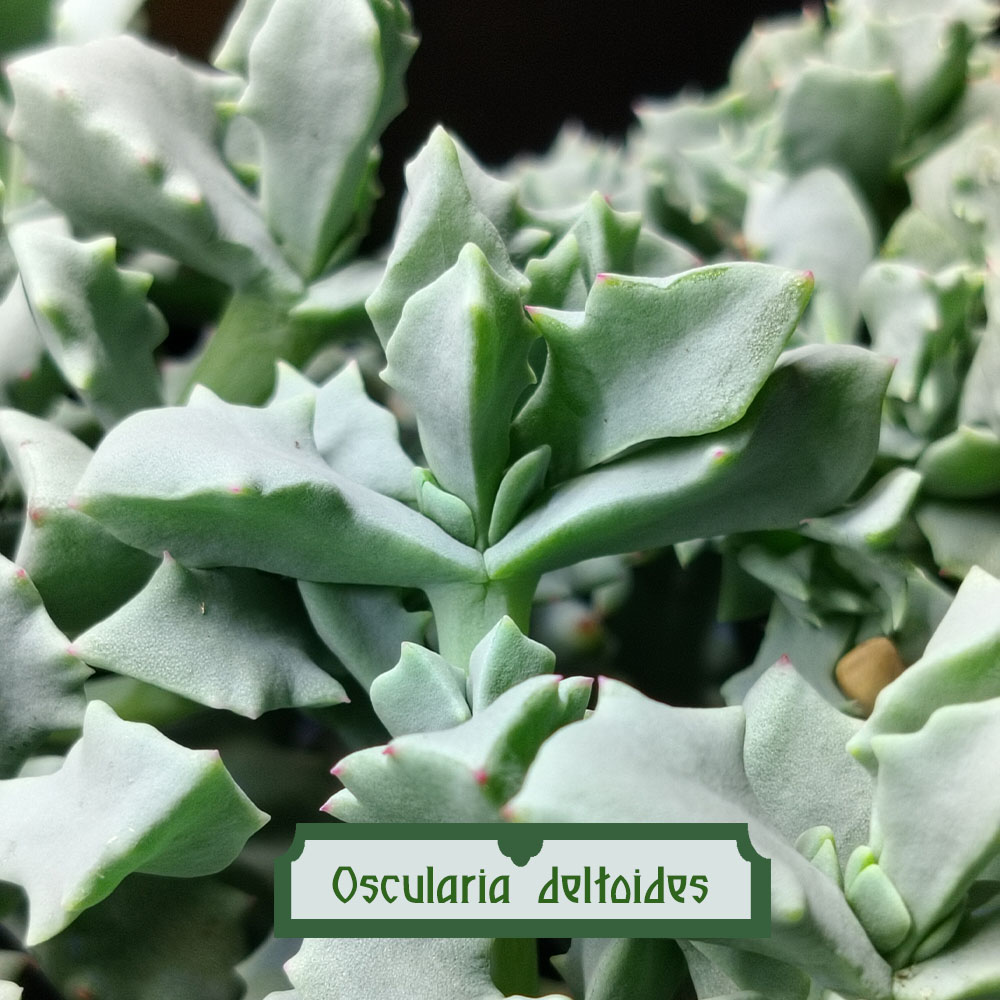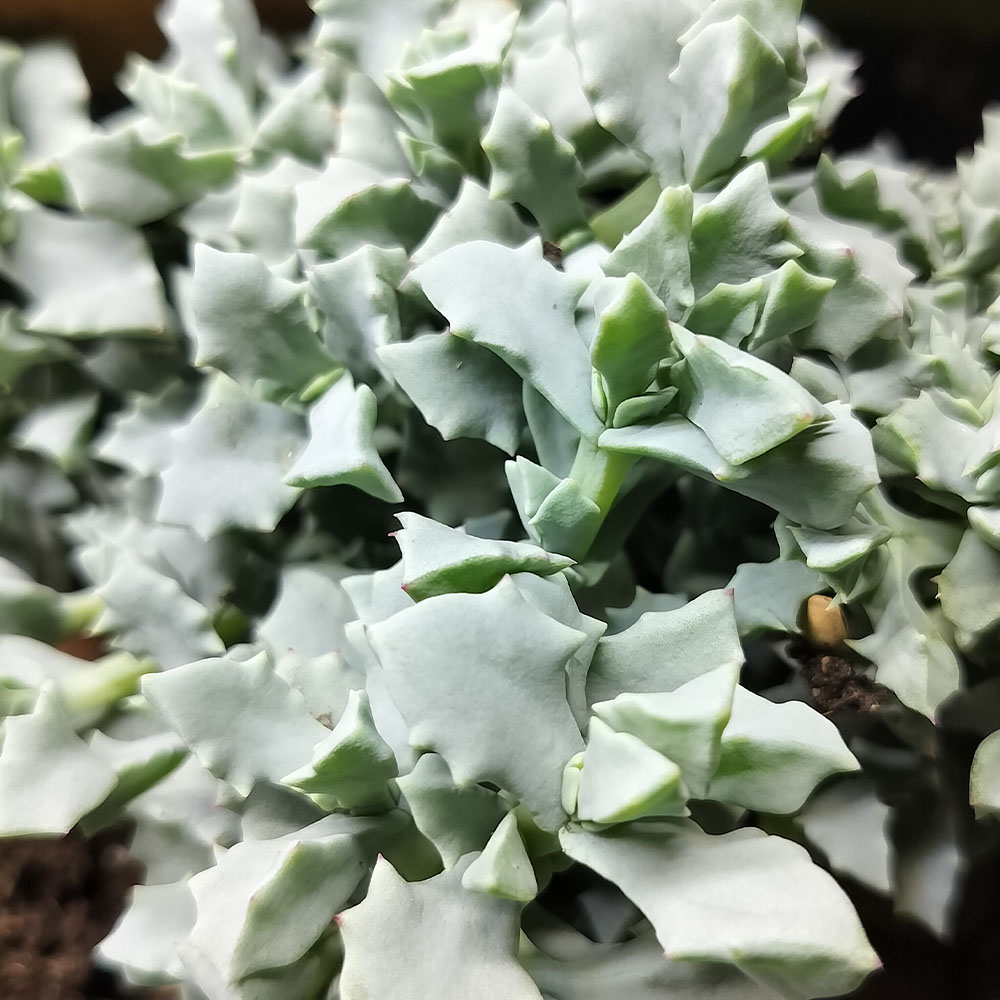No products in the cart.
Oscularia deltoides
A grey blue toothy succulent that forms a small, clumping bush.
Rated 0 out of 5
0 customer reviews
5,00 €
Only 4 item(s) left in stock!
Tags: evergreen, graphique, gris, perennial, persistant, RHS Award of Garden Merit, secheresse, soleil, vivace, vivace en pot
SKU: pda503
Category: Evergreen, Balcony-Friendly, Better Indoors, Grey Ladies, The Stunners

Oscularia deltoides
5,00 €
Only 4 item(s) left in stock!
Oscularia deltoides is an unusual, exceptionally low growing, dense gray succulent shrublet.
This plant smothers the ground 6 inches to 1 foot tall by 2 to 3 feet wide with wiry dark pink stems and blue-green 3-angled fleshy leaves that have small, often reddish teeth.
From spring to summer, small flowers cover the entirety of the plant.
The flowers are small, lightly-almond scented, lavender-pink flowers that open in the afternoon.
Plant in full sun to light shade in a fairly well-drained soil and irrigate little to regularly.
Hardy down to around -7°C and maybe a bit less for short durations – listed by most as hardy to USDA zone 8b.
As with many iceplants this plant provides a stunning show when in full bloom and the interesting foliage makes it an attractive plant year-round. Ideal for slopes, borders or containers.
👩🌾GARDENING TIPS👩🌾:
-
- Thrives in full sun and well-drained soil, making it ideal for rock gardens, succulent arrangements, or as a potted plant.
- If the winter is particularly frosty – bring her inside. She is tough, but South African nonetheless.
- The plant communicates:
- well watered plants in full sun are more plump and create a denser groundcover
- less watered plants in shady corners are a bit thinner and can take on reddish hues in the summer
Learn more about care for these succulents/indoor plants:
-
-
Comment entretenir vos plantes d’intérieur ? (En Français)
-
Growing plants indoors: A beginner’s guide (In English)
-
The Tales:
The name Oscularia comes from the Latin word ‘osculum‘ for “little mouth”.
‘Oscularia‘ means “a collection of little mouths” – a reference to the way the leaves appear as open mouths (teeth and all).
The specific epithet comes from the Latin word for triangular, referring to the triangular shapes of the leaves. I would have said pyramidal, but nobody asked me 🙂
This plant grows only on sandstone rocks in its native range, which extends along low mountainous regions from Ceres to George just to the north of the Cape Peninsula in south Africa.
It used to belong to the Lampranthus family.
Other Names:
Deltoid-leaved dewplant
Dassievygie
Sandsteenvygie
Origin:
South Africa
| Weight | 0,5 kg |
|---|---|
| Flower Color | 🩷 Pink |
| Flowering | March |
| Exposure | Full Sun |
| Soil | Sandy, Well-Draining, Rocky/Well-Draining |
| Frost Tolerance | -1°C to -5°C |
| Size | 0.3m H x 0.8m W |
Reviews
0
Rated 0 out of 5
0 customer reviews
5
0
4
0
3
0
2
0
1
0
Only logged in customers who have purchased this product may leave a review.
You may also like…
Kalanchoe laetivirens – Aranto
A cultivar with larger all-green leaves and thousands of pups along their broad edges.
A cultivar with larger all-green leaves and thousands of pups along their broad edges.
Rated 0 out of 5
Kalanchoe pumila
A silver succulent that forms a small, clumping bush.
A silver succulent that forms a small, clumping bush.
Rated 0 out of 5
Graptopetalum paraguayense
A succulent with porcelain color-shifting leaves and an unusual hardiness.
A succulent with porcelain color-shifting leaves and an unusual hardiness.
Rated 0 out of 5
Crassula ovata ‘Hobbit’
Unusual variation on the Jade Plant
Unusual variation on the Jade Plant
Rated 0 out of 5
Related Products
Artemisia abrotanum
A highly fragrant, medicinal and striking grey-green bush.
A highly fragrant, medicinal and striking grey-green bush.
Rated 0 out of 5
Helichrysum italicum
An evergrey, fragrant perennial that will bring a distinctly Mediterranean atmosphere.
An evergrey, fragrant perennial that will bring a distinctly Mediterranean atmosphere.
Rated 0 out of 5
Potentilla anserina
A distinctly silvery, silky and lacy perennial.
A distinctly silvery, silky and lacy perennial.
Rated 0 out of 5
Sedum spectabile Septemberglut
A species of flowering plant in the stonecrop family – drought tolerant, with vibrant pink flowers and a spectacularly long flowering period.
A species of flowering plant in the stonecrop family – drought tolerant, with vibrant pink flowers and a spectacularly long flowering period.
Rated 0 out of 5
Jacobaea maritima
A wooly white perennial plant from the Mediterranean region.
A wooly white perennial plant from the Mediterranean region.
Rated 0 out of 5
Tanacetum densum subsp amani
A shrublet composed of soft, finely divided silvery gray-white leaves.
A shrublet composed of soft, finely divided silvery gray-white leaves.
Rated 0 out of 5
Lavandula angustifolia
A highly aromatic, flowering perennial used for cooking in many cultures
A highly aromatic, flowering perennial used for cooking in many cultures
Rated 0 out of 5
Salvia sclarea – Clary Sage
A fuzzy perennial that is largely grown for its essential oil.
A fuzzy perennial that is largely grown for its essential oil.
Rated 0 out of 5
Cerastium tomentosum var. columnae
A grey-green spreading ground cover from the mountains.
A grey-green spreading ground cover from the mountains.
Rated 0 out of 5
Artemisia Valerie Finnis
A semi-evergreen, aromatic variation on the theme of Artemisia.
A semi-evergreen, aromatic variation on the theme of Artemisia.
Rated 0 out of 5
Mertensia maritima
A deciduous perennial with fleshy, blue-grey-green leaves that naturally thrives on the wind and sea swept coasts
A deciduous perennial with fleshy, blue-grey-green leaves that naturally thrives on the wind and sea swept coasts
Rated 0 out of 5
Stachys byzantina
Silky white-grey leaves and tall striking flowers
Silky white-grey leaves and tall striking flowers
Rated 0 out of 5
Euphorbia myrsinites
Known for its draping form of silver-gray foliage and radiant blooms.
Known for its draping form of silver-gray foliage and radiant blooms.
Rated 0 out of 5
Salvia officinalis
A fragrant herb used in many cultures for cooking and deserts.
A fragrant herb used in many cultures for cooking and deserts.
Rated 0 out of 5
Artemisia alba subsp camphorata
A highly fragrant, grey-green bush.
A highly fragrant, grey-green bush.
Rated 0 out of 5
Helichrysum orientale
A perennial with soft, ash gray foliage and yellow button flowers
A perennial with soft, ash gray foliage and yellow button flowers
Rated 0 out of 5
Koeleria glauca Blue Sprite
An ornamental, low growing blue grass
An ornamental, low growing blue grass
Rated 0 out of 5
Nepeta x faassenii
Catnip is known for its grey-green, aromatic foliage and masses of lavender blue flowers.
Catnip is known for its grey-green, aromatic foliage and masses of lavender blue flowers.
Rated 0 out of 5
recent view product
Thymus longicaulis ‘Odoratus’
A fast-growing ground cover with strongly aromatic leaves, and bright pink flowers in early summer.
A fast-growing ground cover with strongly aromatic leaves, and bright pink flowers in early summer.
Rated 0 out of 5
Glechoma hederacea Dappled Light
A fragrant ground cover with brightly colored and unusual foliage
A fragrant ground cover with brightly colored and unusual foliage
Rated 0 out of 5
Campanula persicifolia ‘Telham Beauty’
A stately porcelain colored beauty
A stately porcelain colored beauty
Rated 0 out of 5
Thymus Coccineus – ‘Creeping Red’
Deep-green, aromatic foliage that is sprinkled with light rose-coloured flowers all summer-long.
Deep-green, aromatic foliage that is sprinkled with light rose-coloured flowers all summer-long.
Rated 0 out of 5
Sedum moranense
A heather-like ground cover with delicate star shaped flowers
A heather-like ground cover with delicate star shaped flowers
Rated 0 out of 5




























































There are no reviews yet.